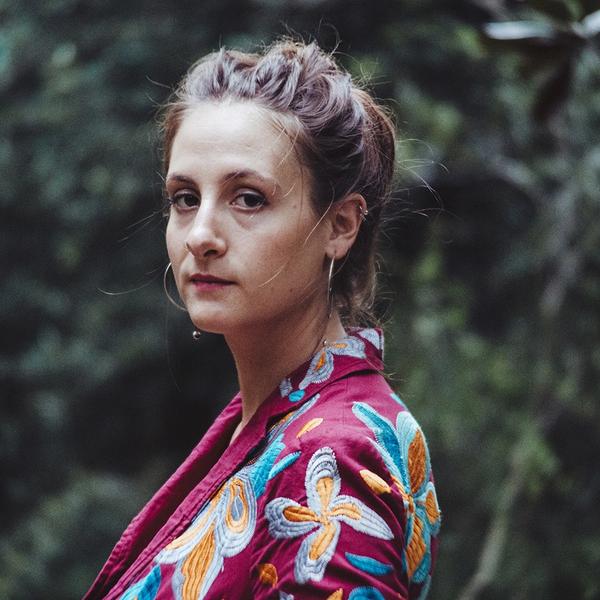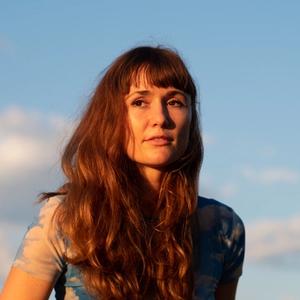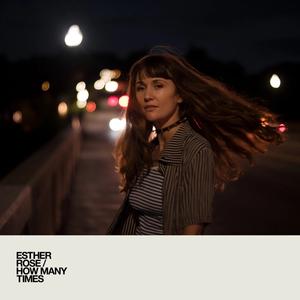




Link copied

It’s February and love is in the air everywhere. Unfortunately, we can’t all be hopelessly and happily in love and sit about mooning over each other all month. For some of us, the endless stream of photos of happy couples on Instagram is just a painful reminder that we’re feeling a little bit lonely - which makes it the perfect time for a nice healthy dose of heartbreak songs! And for those of you that need it, we’ve got the perfect record.
The debut 6-track EP from Gina Leslie, No, You’re Crying, is flavoured with the kind of sweetened melancholy that will warm your broken heart and fill it with hope. Floating somewhere between country and jazz, her songs weave together pedal steel, fiddles, organ, clarinet and luscious harmonies, carefully tempering their sophistication with an unpretentious simplicity, as she sings about love and life and all the different ways it can go wrong.
Born into a musical family in Colorado, she spent the better part of her formative years barefoot at bluegrass festivals, fiddle camps and crowded family jams. After years of honing her voice as an artist and songwriter, the New Orleans-based singer now steps up to take centre stage with a selection of songs about love and loss and everything in between. Those moments when you’re still trying to cling on, but there’s nothing to cling on to anymore. Those moments when you finally let go.
With most of her life devoted to playing everything from bluegrass to folk to jazz, she has absorbed a huge swath of American music and made it her own. Her songs feel ageless and traditional, tinted with the patina of personal experience and played with a lightness of touch that only makes the sadness feel more poignant; balancing it out with a gentle reach for happiness that makes the songs sound strangely hopeful at the same time.
Also well known as a side musician, recording and performing with countless artists in New Orleans and beyond - The Sam Doores Band, Ric Robertson and her family band, The Bad Bad Leslies – she first came to our attention here at Holler playing electric bass and adding harmonies to Esther Rose’s How Many Times last year.
Now, as she strikes out on her own, we spoke to Gina Leslie about her upbringing, writing songs and making the new record.
Watch the brand new video for 'Little Company' premiering on Holler below.
Where are you from and how has that influenced your music?
I come from a bluegrass family in Evergreen, Colorado, going to fiddle camps and music festivals whenever we weren’t in school. I started playing fiddle when I was five, and playing music was just what we did as a family. Growing up around folk and bluegrass music that is such an oral tradition – with everything passed down and learned by ear, sitting in a circle – has had a profound influence on me.
One particularly formative anchor in my musical life has been Rockygrass Academy & Festival, in Lyons, CO, where my family has now been going for 25 years in a row. This is where I learned so much about taste and musicality, jamming for hours on end in the campgrounds, where there’s the freedom to just play freely and mess up, to jump in singing a harmony, or to play an instrument you don’t “know” without pressure or judgement.
It’s taught me so much about the importance of listening more than needing to be heard, about being part of a groove, or about how to respond to what others are doing, because music is so much like a language and a conversation. Even though I don’t consider myself a “bluegrass” musician, it’s where I come from and it will always have an influence on how I feel other styles of music.
Living in New Orleans now, when I learn a jazz standard or play with different bands here, I can feel that I bring a different compass to the table, a different North Star that is exciting to mix into the pot.
What did you listen to growing up?
A lot of what you might expect from a bluegrass family - John Hartford has always been king. Tim O’Brien, Doc Watson, Tony Rice, David Grisman, Bruce Molsky, Del McCoury, Old and In The Way, all those acoustic gems were always playing in my house. My parents still have their vinyl collections from the 70s, and immersed us in all those classic records - Miles Davis, Joni Mitchell, The Beatles, Django Reinhardt & Stephane Grappelli, Stevie Wonder, Tom Waits, Ray Charles, Carole King, Merle, Willie, the list goes on and on.
Did that change as you got older?
I had a real angsty teenage phase where I thought bluegrass music was so un-cool, and I tried to distance myself from that part of my family and background. This was pre-Oh, Brother. I quit playing music for several years, and put down my fiddle with fierce disdain.
Starting to do a deeper dive exploring music on my own, in high school I became enamored with jazz singers like Ella Fitzgerald, Chet Baker, Louis Armstrong, Peggy Lee, The Mills Brothers. This eventually brought me back to playing again in early college, when I found music that I connected to and wanted to play and sing. I started playing the ukulele because I could accompany myself singing, and there is a huge online community of jazz-uke enthusiasts. I basically taught myself some jazz theory and chord / song structures that translate straight over to the guitar.
When and where did you write the songs on No, You’re Crying?
Most of these songs are from a particular time in my life, living in New Orleans and going through heartache like I hadn’t experienced before. I finished ‘Little Company’ sitting on a bench in Armstrong Park, and the main hook of ‘Month of Sundays’ came in a flash while I was dancing at Blackpot camp and someone asked me where my sweetheart was. I remember the dance ended and I ran over to write that line down before it slipped away. I think back on this set of songs as somewhat of a time stamp of when I lived at a certain yellow house, and was going through what I thought was a heartbreak that I would never heal from.
Where did you record it and what was it like?
I recorded these songs at my friend Ric Robertson’s home studio in New Orleans. Ric has been like a brother to me since we met over 15 years ago, and was the first person to come to mind when thinking about recording these songs. He and I went in and started building the tracks just the two of us, when we realized we needed another set of hands and ears. So I called another old friend, Charlie Rose, and he flew down on a whim the week before Mardi Gras 2020, bringing with him a pedal steel, banjo guitar, and an assortment of cool sounding percussion toys.
We spent a week getting the basic drums-bass-guitars down, amidst the crazy whirlwind of Mardi Gras, and added the magic sprinkle of Sam Fribush on keys, and Bryce Eastwood on horns. This was all just a few weeks before the pandemic hit and stalled the project for a while. It feels lucky to me that this recording was one of the last things I did pre-pandemic. Over the course of the pandemic, I chipped away at it piece by piece – I self-recorded my vocal harmonies at home, and sent tracks to Alex Hargreaves and Alec Speigleman who overdubbed their own string and horn parts, respectively.
We put the finishing touches on it and mixed it at Sam Fribush’s home studio in Greensboro, NC in January 2021. I love working in home studios, because what you miss in state-of-the-art gear and tools, you gain in the freedom to try things many different ways until it feels right. We recorded ‘High and Dry’ several times with a lot of different feels until we landed on what it is now.
I love the artwork for your EP. How important is the visual aspect of putting out a record to you?
It’s so crucial. I grew up combing the vinyl records at my house and have always been captivated by the physical connection to holding the record in hand.
In my teen angst phase that I mentioned, I got deep into visual art, and went to college for Graphic Design & Photography. I worked for several years in the design world, including making movie and TV posters in Los Angeles. When I quit that job and moved to New Orleans to play music, I transitioned my design work into making album art for other musicians, and have designed at least 30 records in the past several years. I was thrilled to make my own album art after doing it for so many others. I took illustrations out of my journals from the time that these songs were written, and adapted them to be the covers for the singles leading up to the whole EP.
I’m also obsessed with pink right now, after years of believing the complete nonsense that I couldn’t be a strong lady and also wear pink. Now I’ve embraced it and am in the process of DIY-ing a whole merch line that is full-on pink.
With songs, are you drawn to the words first or the music?
I’m drawn in by the music, and stay for the lyrics.
How easy does writing songs come to you?
Writing chord progressions and melodies comes so naturally to me. It’s the lyrics that I really end up laboring over. I can sit down and noodle on chord changes that feel interesting and come up with a new “seed” for a song with such ease, then often spend an excruciatingly long time trying to find the right words. It’s the occasions when the words and the music happen at the same time that the song comes quickly. I have song seeds from years ago that I still haven’t finished because I’m so picky with lyrics. That’s what I’m trying to break out of - feeling precious over an idea, and instead allowing myself to use nonsense to get unstuck - like how Paul McCartney used “scrambled eggs” as a placeholder until he found “Yesterday”.
You’re also known as a side musician, recording and performing with countless artists in New Orleans. How has it been different being out on your own, leading the music for this album?
It’s been a great learning and growing experience. I was more used to preforming and recording as a side musician, where my natural tendencies to go with the flow and support and shape-shift can shine, but it’s been empowering to step into the leader role and call the shots. I’m grateful to play with amazing musicians who I trust immensely and who “get” me, while also bringing their own unique personalities. It’s really sent me on a quest to get to the heart of what I’m trying to say with music and how to present it. There’s no hiding behind someone else’s songs or band, so it’s vulnerable and scary at times, but it feels closer to my heart and that is what I’m chasing.
What was your favourite song to write on No, You’re Crying?
‘How Many Waltzes Is Too Many Waltzes’ immediately comes to mind. I co- wrote that song with my dear friend Elise Leavy on a summer’s evening in Berkeley, CA on the eve of my birthday. The title line came from a genuine question about how many waltzes can really be on one set list, and we both looked at each other, wide-eyed and knew we had to write that song.
We gave ourselves about 15 minutes to write individually on the topic and those poems became the first and third verses. The bridge came out on the first try and then we spent the next few hours puzzling together the second verse. The whole song was done in one night. I hear songwriters talk about songs coming to them like that as a divine gift, and it really does feel like it just came out of us.
Who would be your dream collaboration?
In my wildest dreams Willie Nelson calls me to the stage. But sincerely, it would probably be going back to my roots and playing with the people I learned from and have been influenced by since I was a kid, like Tim O’Brien. Also, it sounds cheesy, but I dream of playing with my family. We’re all busy doing our own things musically, and are lucky enough to see each other and jam pretty regularly, but I have a long-term vision of playing festivals and shows with my brothers someday.
I saw John Prine play with the Colorado Symphony Orchestra the year before he passed, and it was one of the most incredible shows of my life. The idea of playing with a symphony of strings, horns, and bowed basses lights me up.
What’s next for you?
This spring is going to be a wild flash of musical collaborations. No, You’re Crying comes out on February 11th, and at that same time I will be playing bass on some friends' records, like Sam Doores and The Lostines. Looking forward to playing lots of local shows with all kinds of different New Orleans bands, which I love doing more than just about anything. Then I’m going to take some quiet solo time to write, write, write. That’s what I’m looking forward to the most.
No, You're Crying is released on February 11th on Omgina





